When I first came across these beautiful Ernst Haeckel prints, I couldn’t wait to share them. These are some of the most beautiful vintage nature art drawings I have seen.
The vintage biological illustrations just blew me away. I can’t wait to get a few of these nature wall art prints on my wall. I will also be crafting with them.
Ernst Haeckel & “Kunstformen der Natur”
Ernst Haeckel was a German zoologist, naturalist and artist in the 20th century who discovered, described, painted and named thousands of new species in the animal kingdom.
All the Ernst Haeckel prints are from his most famous book “Kunstformen der Natur”, which aptly translates as “Artform In Nature” -as these illustrations transcend science into art.
His beautiful 20th Century nature drawings influenced other disciplines such as architecture, art and design. Haeckel’s prints mainly influenced artists within the Art Nouveau movement. There are some great Art Nouveau Animal designs here, and you should check out the pochoir prints of butterflies by Seguy and his art nouveau insect plates.
I have just concentrated on his marine illustrations for this curated collection of Ernst Haeckel prints. As these are the most beautiful and art-like.
I’ve divided the collection into 2 parts, firstly the colourful illustrations and secondly the monochrome prints.
To download a higher resolution Ernst Haeckel print just click on the title above the image you want.
The Colour Ernst Haeckel Prints
1. Siphonophorae Marine Creatures
Siphonophorae is marine creatures such as jellyfish and corals. They appear to be a single organism; each specimen is a colonial organism composed of small individual animals called zooids that have their special function for survival.
Some Siphonophorae are know to be up to 50 meters in length and others can emit light. Some such as the Portuguese Man O’ War have a deadly sting.
2. Desmidiaes – Green Algae
These Ernst Haeckel prints of green algae are a great example of the finding artform in nature.
3. Actiniae – Sea Anemones
A colourful vintage illustration of sea anemones in their marine environment. Sea anemones are named after the anemone flower because of their lovely colours and appearance.
Sea anemones are similar to jellyfish and coral because most sea anemones capture their prey with stings and toxins. Some of them are even highly toxic to humans, and these toxins in some cases, can be lethal.
4. Ascidiea – Sea Squirts
These beautiful colourful illustrations of Ernst Haeckel are sea squirts. Depending on the species and habitat, sea squirts come in various colours, such as green, yellow, red, orange, pink, blue, brown or white.
They get their name as when touched the sea squirt ejects water from the siphon.
Sea squirts are marine creatures that feed by filtering. They absorb water with edible bits through the siphon and then separate the nutritious plankton and algae from the water. A few species of sea squirts have tentacles to catch jellyfish and other small fish.
5. Anthomedusa – Marine Creatures
These marine creatures in this Ernst Haeckel illustration are known as Anthoathecata.
6. Discomedusae – Marine Creatures
These are a kind of jellyfish. This is probably one of the more popular of Ernst Haeckel’s prints of marine life.
There is an entire post about Ernst Haeckel’s jellyfish here.
7. Discomedusae 2 – Marine Creatures
A second beautiful vintage illustration of these jellyfish by Ernst Haeckel.
8. Pectanthis asteroides – Marine Life
Another nature artform Ernst Haeckel poster of Jellyfish.
9. Asteridea – Starfish
Below is an artistic nature illustration of starfish. There are over 1,500 species of starfish, and they inhabit all the world’s oceans, from the tropics to polar waters.
Starfish are invertebrates only found in marine water. They typically have five arms in a star shape, hence their name. Starfish don’t have a brain or blood. If they lose an arm, they can grow another one over time.
10. Copepoda – Marine life
Copepods are a group of small crustaceans found in nearly every freshwater and saltwater habitat. Their name means “oar”.
Copepoda is thought to be the most abundant single species on the planet. These tiny creatures are vital to the ocean’s food change.
11. Ernst Haeckel Prints – Polycyttaria
Polycyttaria are a form of mini sea plankton.
12. Ernst Haeckel Prints – Siphonophorae
Siphonophorae is an order of Hydrozoans, a type of marine organism. The order contains 175 species. Like other hydrozoans, some siphonophores emit light to attract and attack prey.
13. Siphoneae
This Ernst Haeckel print from Knustfomen Der Natur is of siphoneae, which is a type of Algae.
14. Florideae
Florideae is a type of red algae. There are more red algae prints in this vintage seaweed print collection.
15. Stephoidea
The Monochrome Marine Life Prints
1. Acanthophracta – Marine Life
These are tiny marine organisms made up of Protazoa. The pattern of these organisms drawn by Ernst Haeckel is wonderful. When I first saw them, I thought they were snowflake illustrations.
2. Acephala – Bivalves
Acephala are bivalves such as cockles, oysters, muscles, scallops and clams. There are over 30,000 species of bivalves. The size of the bivalve shells varies greatly from tiny 0.5mm nut clams to giant clams. The giant clam, Tridacna gigas, can grow to a length of 1.2m and a weight of more than 200 kg.
Scallops and file clams can swim to escape a predator, clapping their valves together to create a jet of water. Cockles can use their foot to leap from danger.
3. Bryozoa – Aquatic Invertebrates
There are approximately 4,000 species of Bryozoa. Colony forms vary among the different species, ranging from flat, encrusted sheets to folded, leaflike bushes.
If a piece of a bryozoan colony breaks off, the piece can continue to grow and form a new colony.
Bryozoans use tiny mobile pincers called “avicularia” to pluck off any settlers that land on them.
4. Cirripedia – Barnacles
Barnacles are marine creatures that live in shallow and tidal waters. They attach themselves to hard surfaces, including the hulls of ships and boats.
They are even found glued to the body of whales, turtles, crabs and other sea creatures. Most animals are unaware of barnacles on their body because they do not produce harmful effects.
5. Cubomedusae – Box Jellyfish
The big box jellyfish is the most venomous jellyfish on the planet. It is so venomous it will kill you within two minutes if you receive two meters or more of tentacle contact.
The only predators of jellyfish are turtles. Thanks to their thick skin and shell, box jellyfish stings do not affect turtles. Only their eyes can be stung.
6. Discomedusae – Jellyfish
Another Ernst Haeckel jellyfish print. A few years ago, I visited a jellyfish aquarium at Ocean Park in Hong Kong; it was one of the most fantastic marine displays I have ever seen. The jellyfish prints of Ernst Haeckel remind me of that experience.
6. Thalamphora – Ernst Haeckel Prints
A poster of marine curiosities and a beautiful example of Ernst Haeckel artistry.
7. Hexacoralla – Ernest Haeckel Prints
Hard corals, many of these sea creatures also feature in the fantastic colourful coral reef illustrations of the Australian Great Barrier Reef.
8. Ophiodea
Brittle stars or ophiuroids are echinoderms and closely related to starfish. They crawl across the seafloor using their flexible arms for locomotion.
9. Ernst Haeckel Prints – Thoracostraca
Thoracostraca is an extensive division of Crustacea. Having a dorsal shield, or nearly all, of the thoracic somites to the head. It includes crabs, lobsters, shrimps, and similar species.
10. Blastoidea
Blastoids (class Blastoidea) are an extinct type of stemmed echinoderm, often referred to as sea buds.
11. Ernst Haeckel Prints – Decapoda
The Decapoda or decapods (literally “ten-footed”) are a type of crustaceans, including many familiar groups, such as crayfish, crabs, lobsters, prawns, and shrimp. Most decapods are scavengers.
12. Teleostei
The teleosts or Teleostei the ray-finned fishes. There are also a couple of sea horses in this Ernst Haeckel illustration.
13. Spumellaria
Another fabulous Ernst Haeckel artform illustration of a type of protazoa.
14. Spirobranchia – Kunstformen der Natur
Haeckel Illustrations of marine life.
There is a stunning Ernest Haeckel hummingbird print too.
If you liked these stunning artistic nature prints of Ernst Haeckel then you should check out some of my other free vintage sea life illustrations.
- Sea Life Posters Adolphe Millot
- Vintage Octopus Illustrations
- Fantastical Fish Paintings of Louis Renard
There are also some fabulous vintage natural history classroom posters of Emile Deyrolle and vintage nature posters of Oliver Goldsmith. You will also find some more wonderful sealife posters in this complete collection of Adolphe Millot and other educational posters on the site.
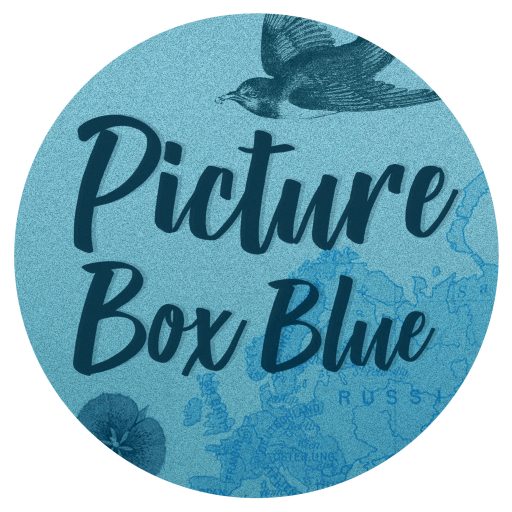
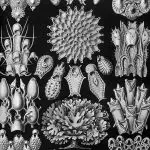
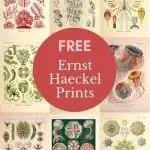
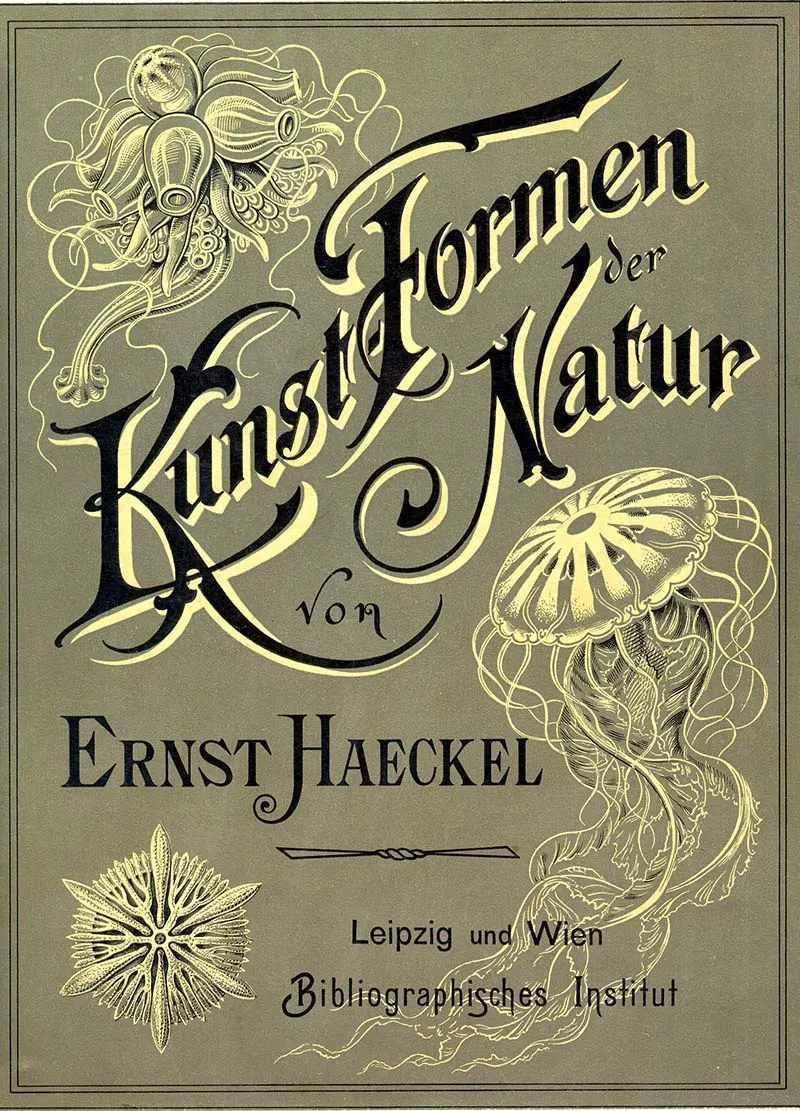
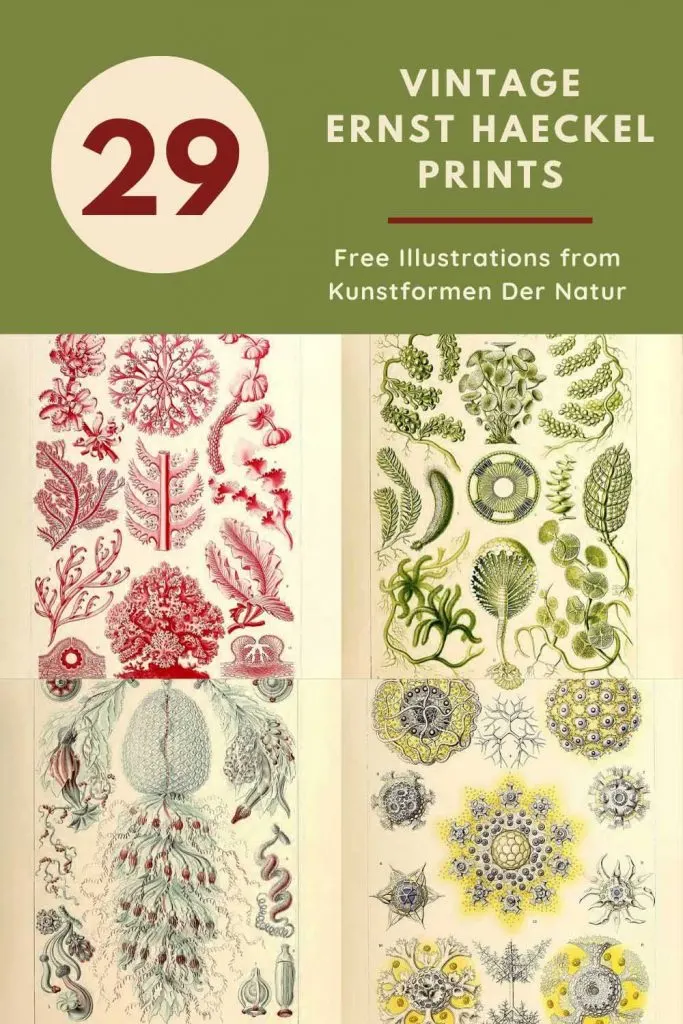
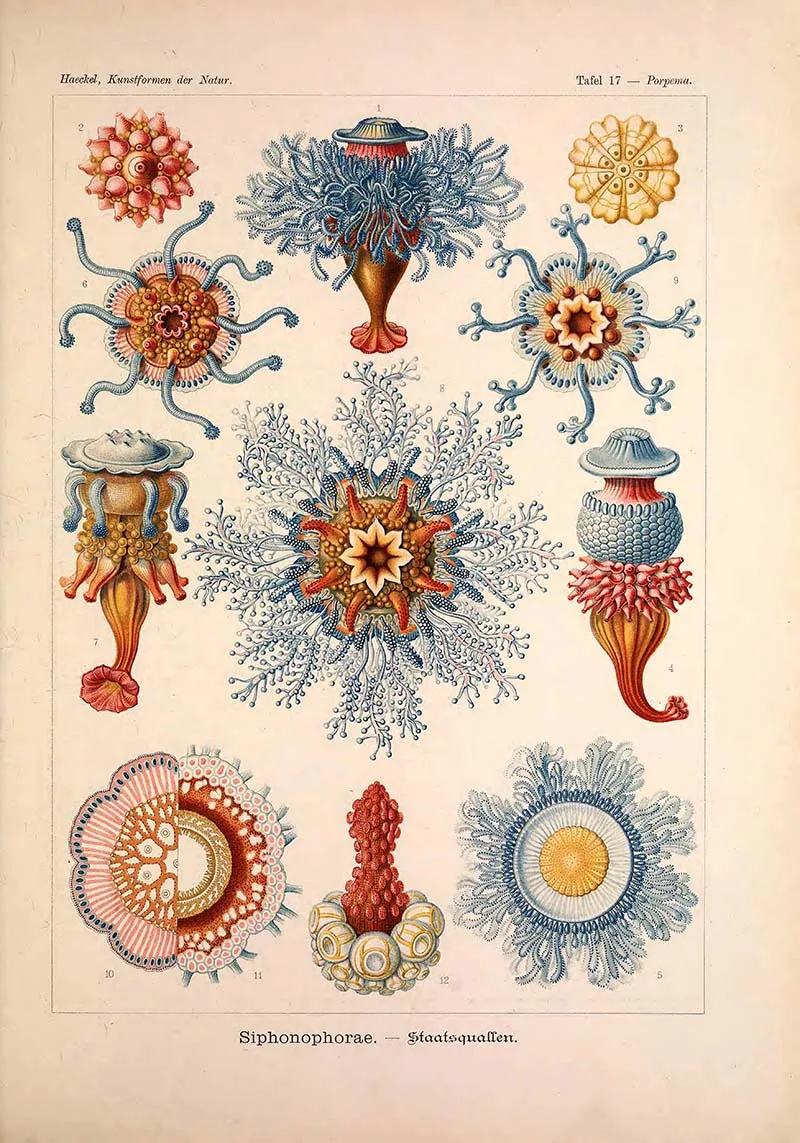

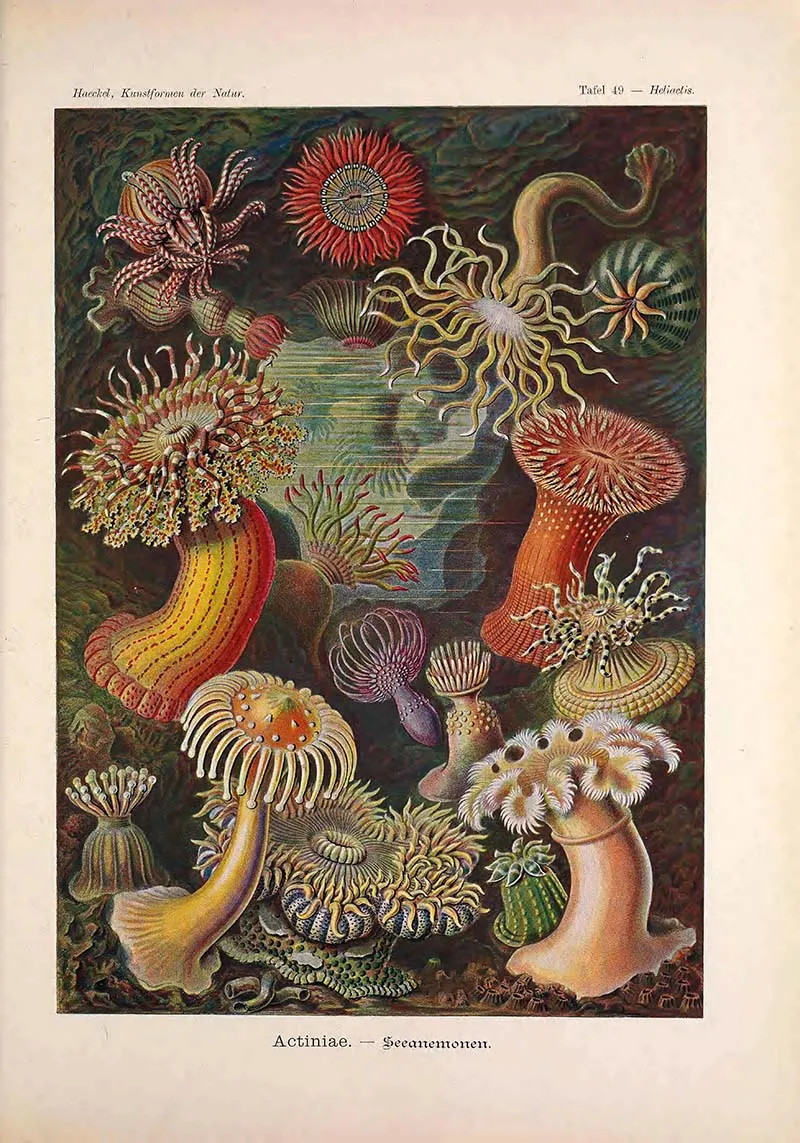
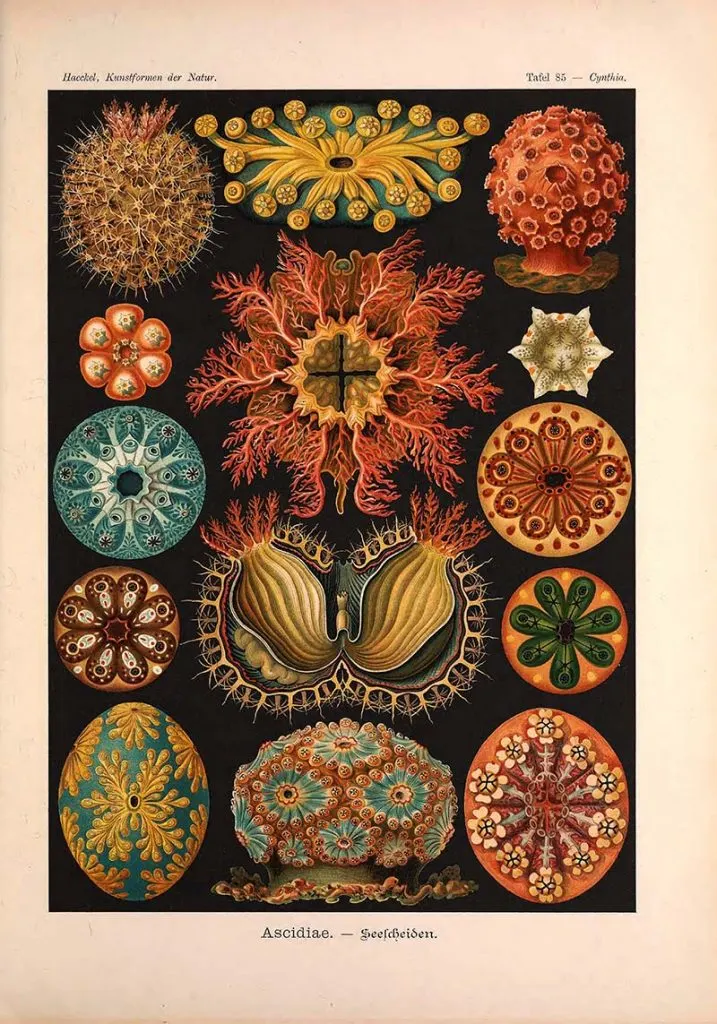
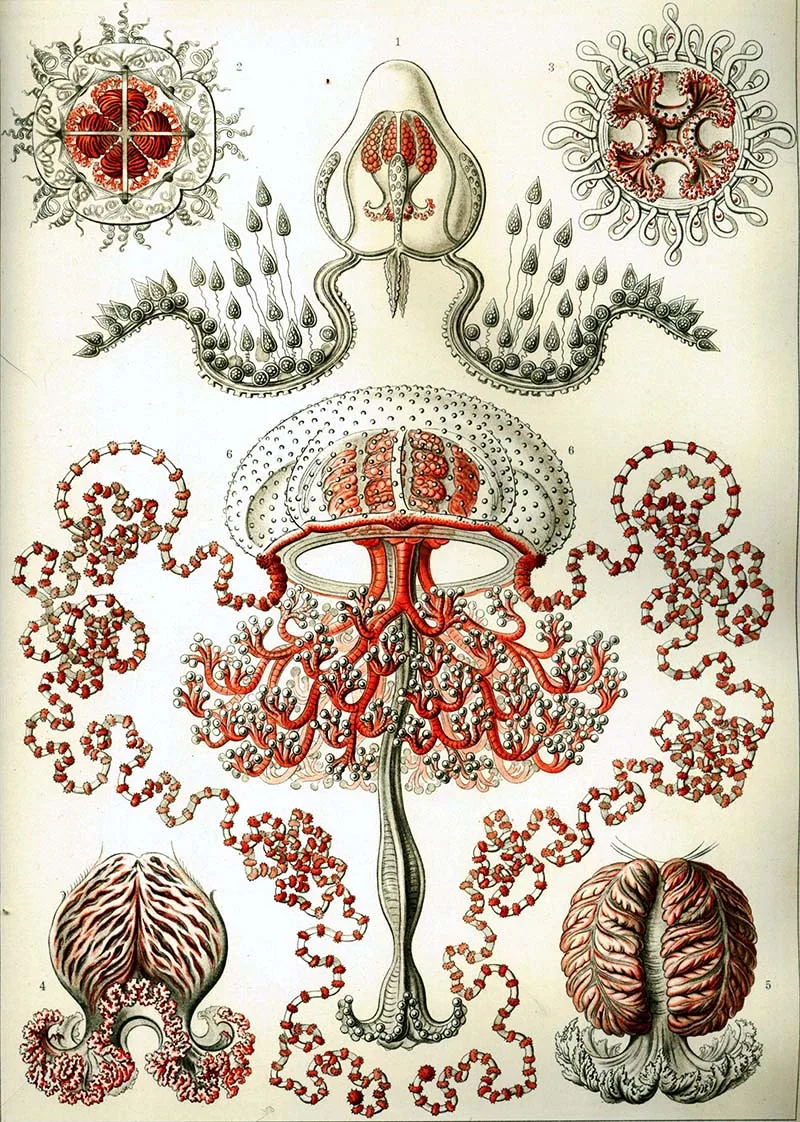
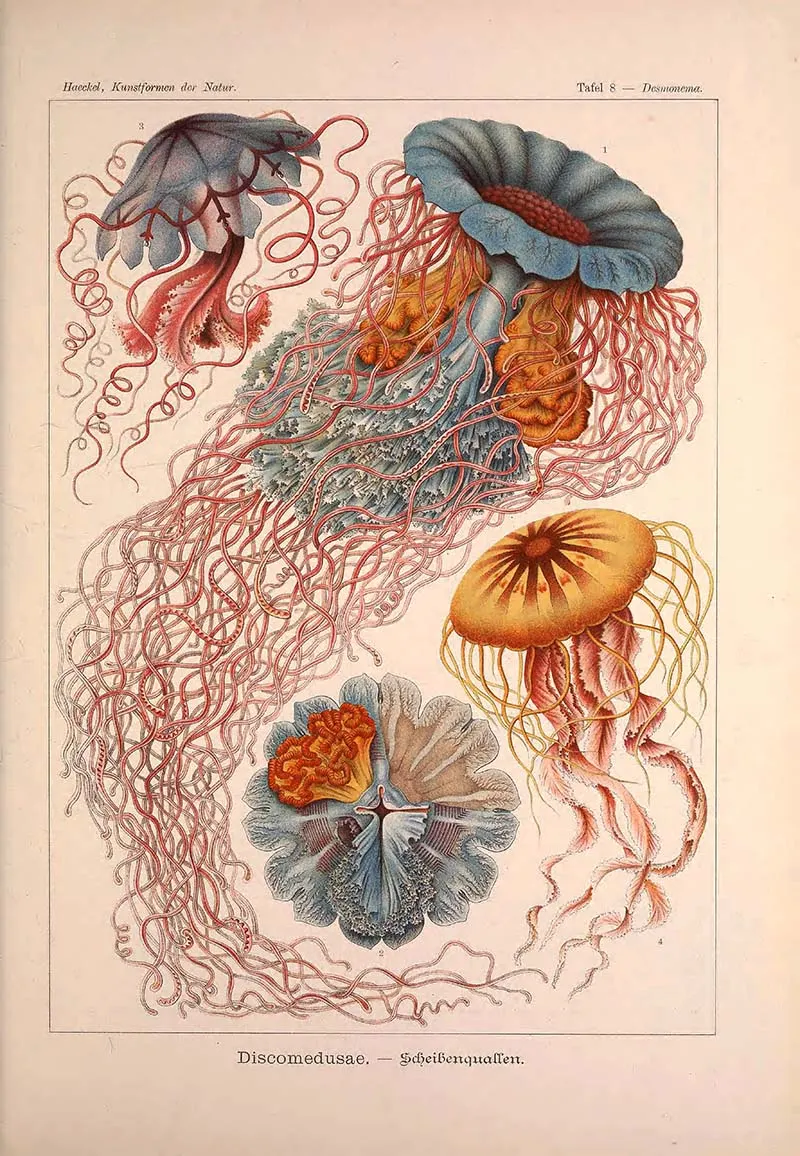
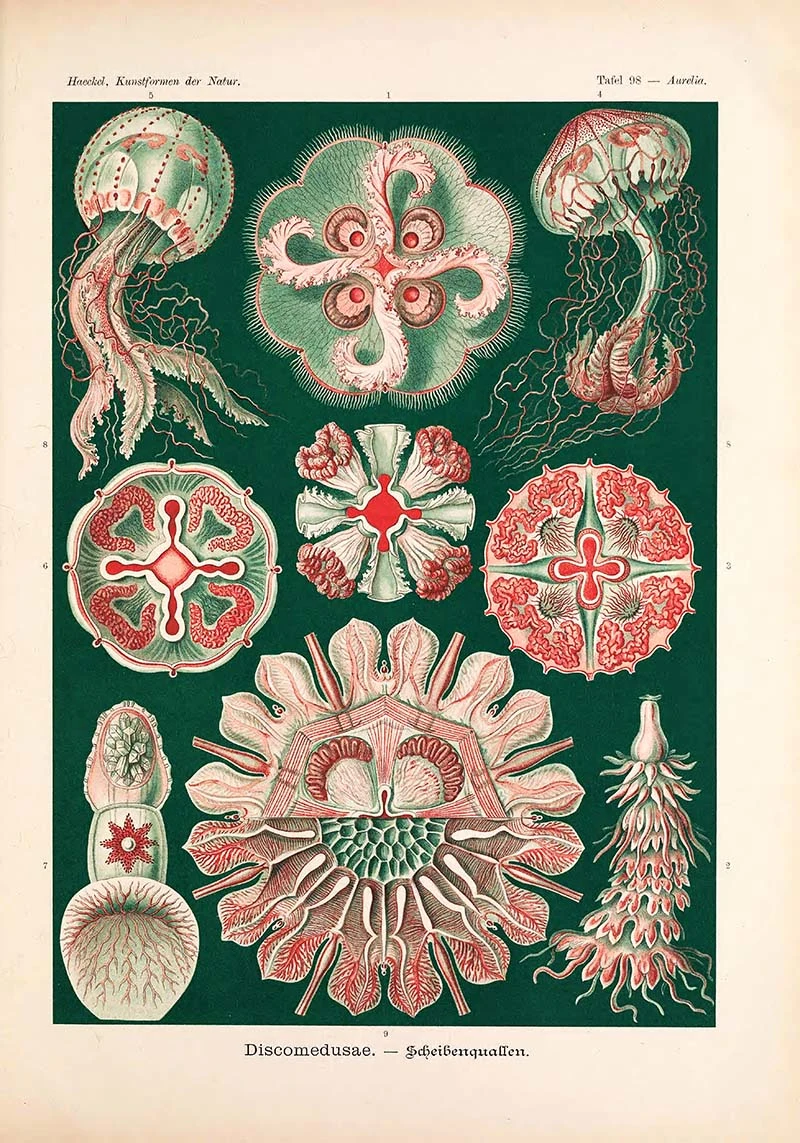
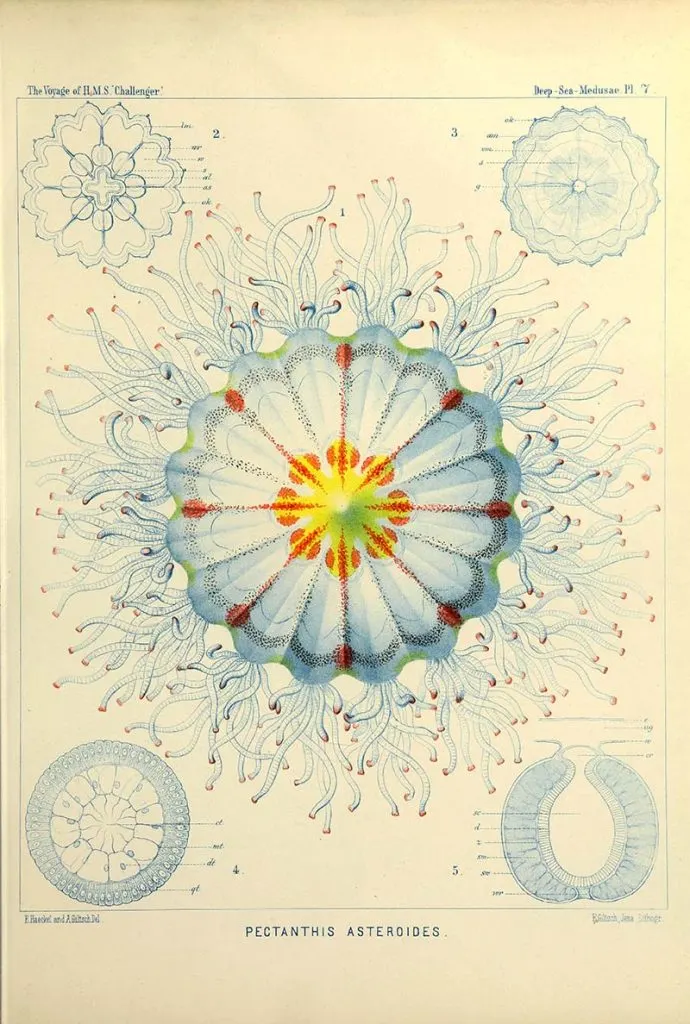
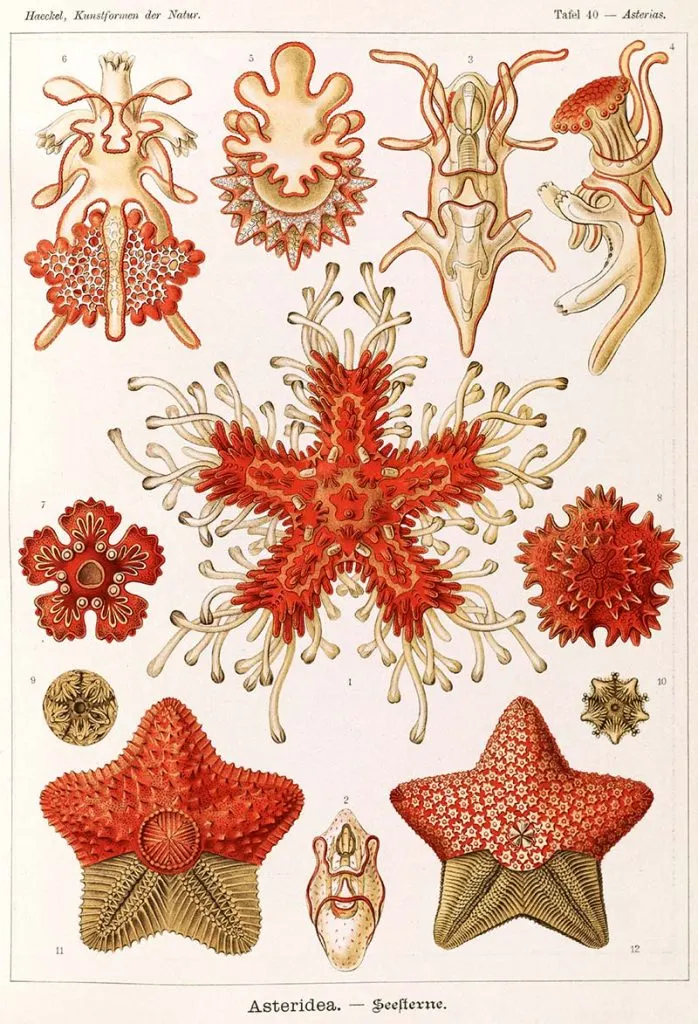
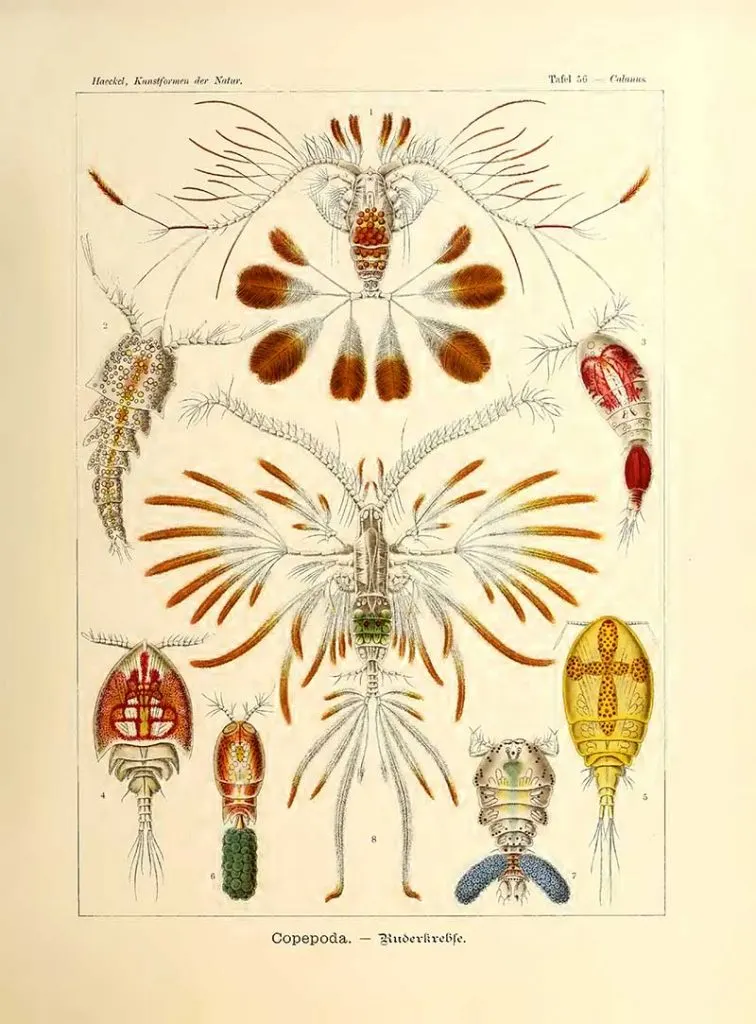
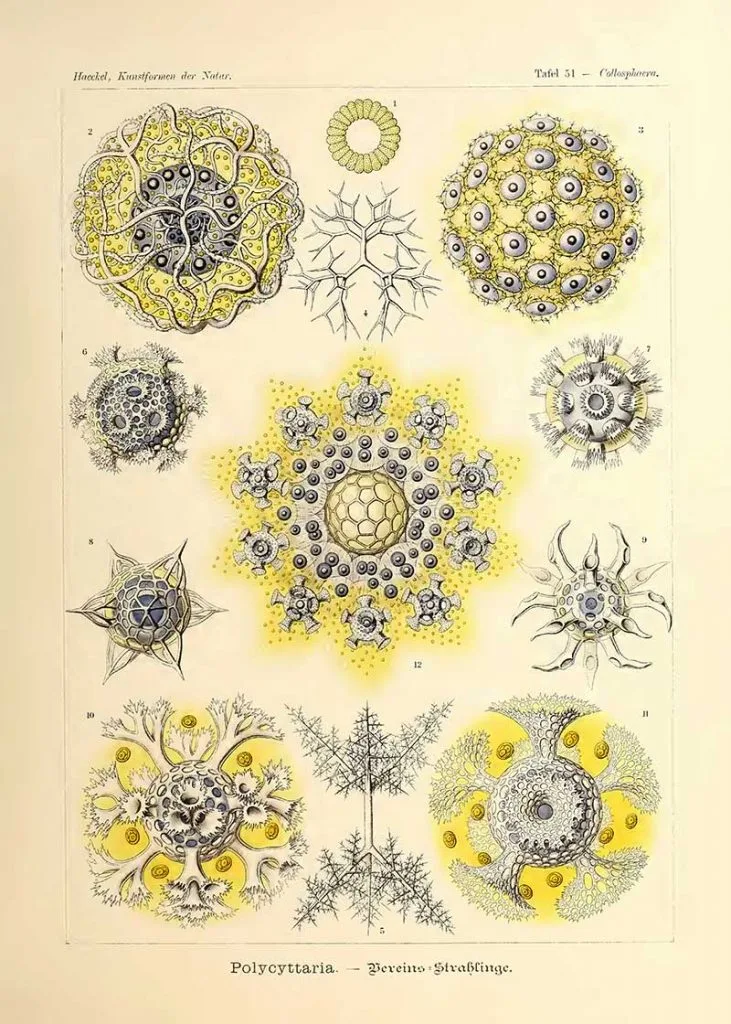
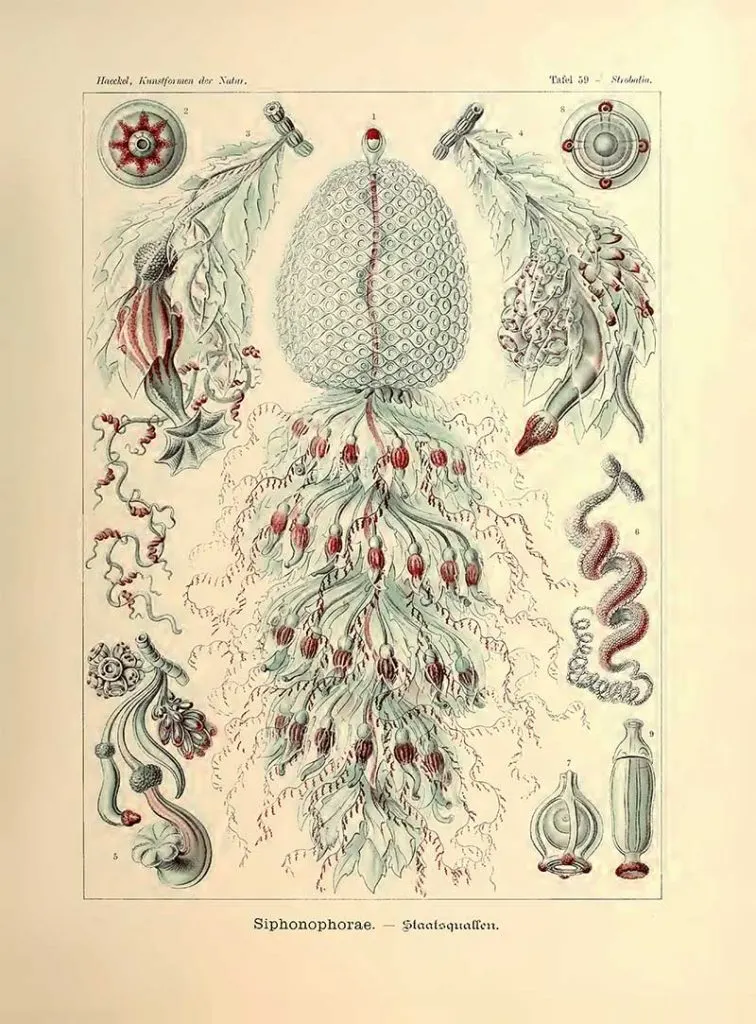
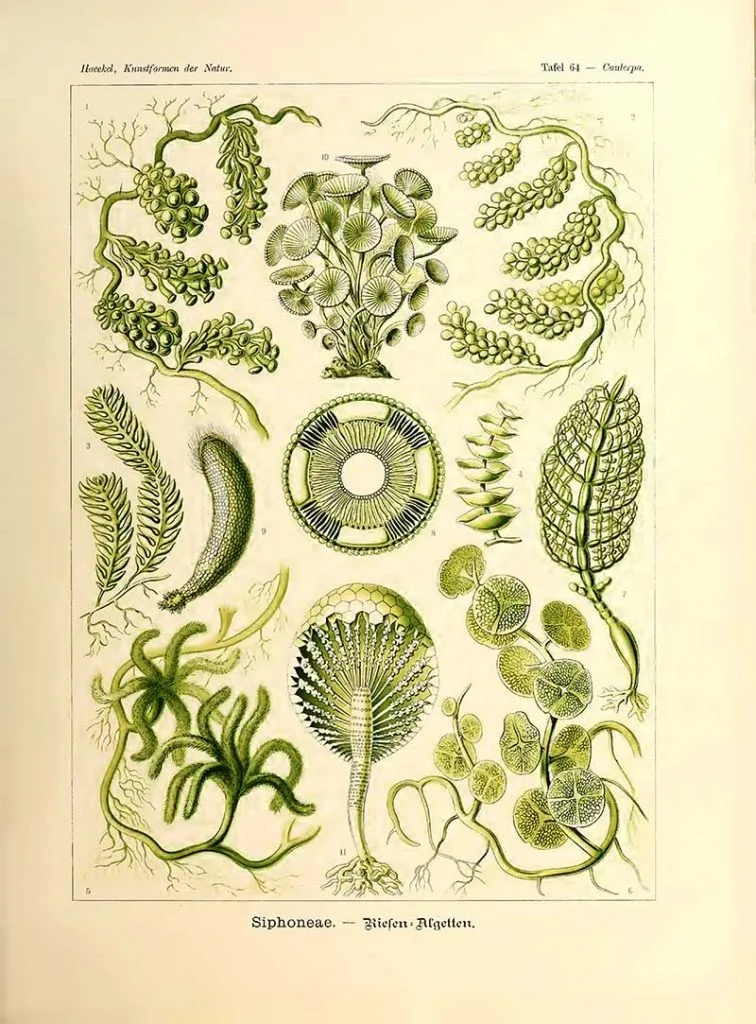

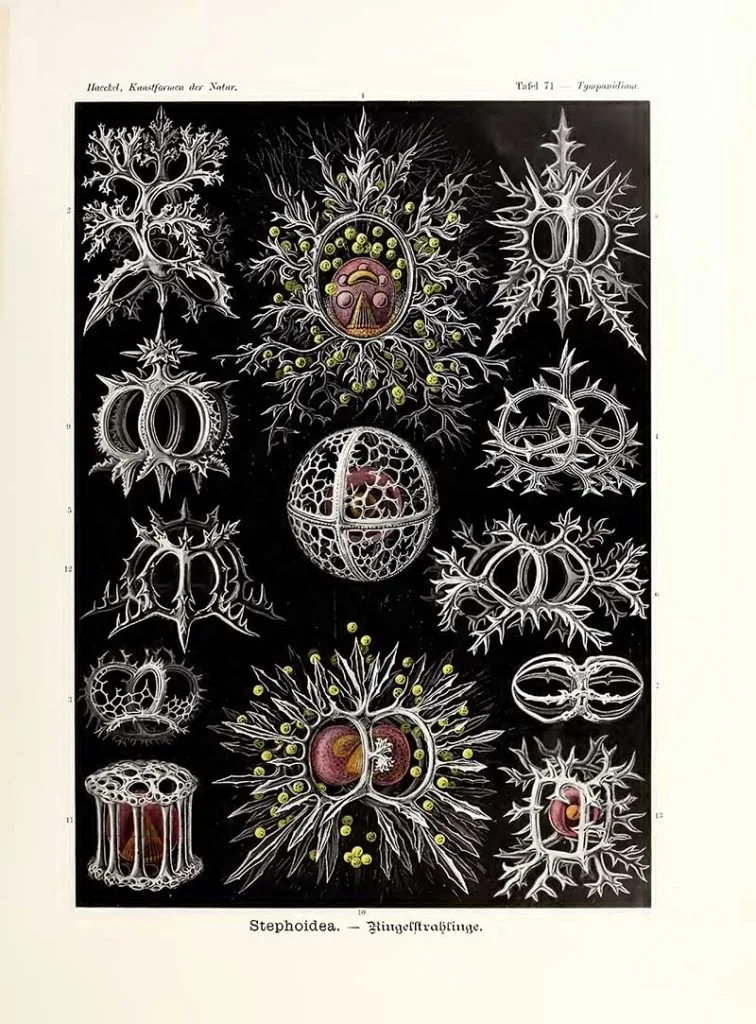
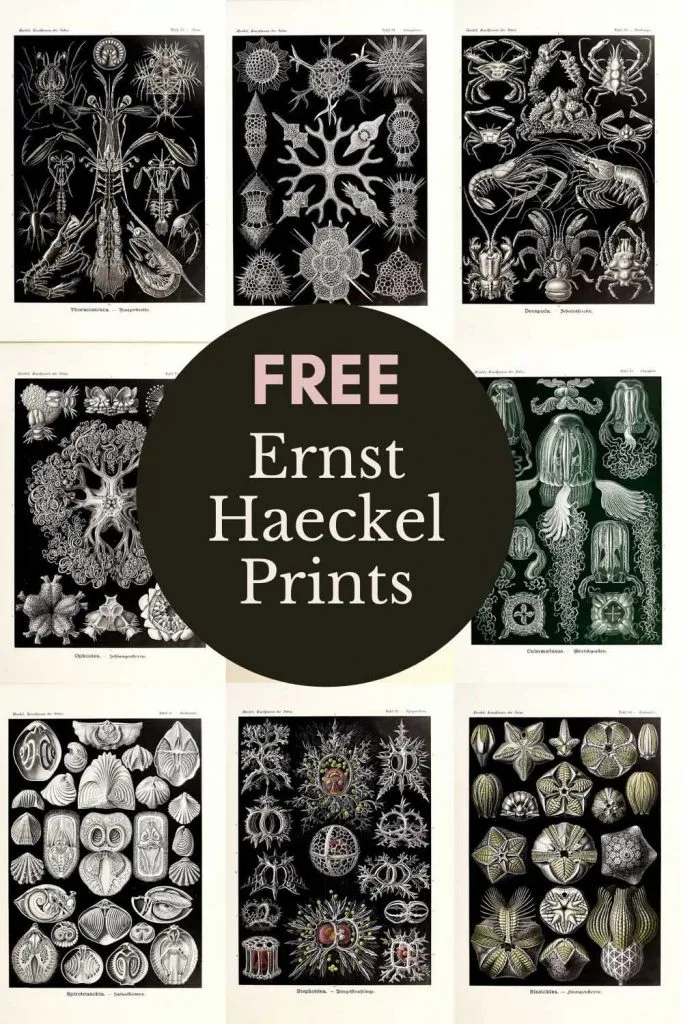
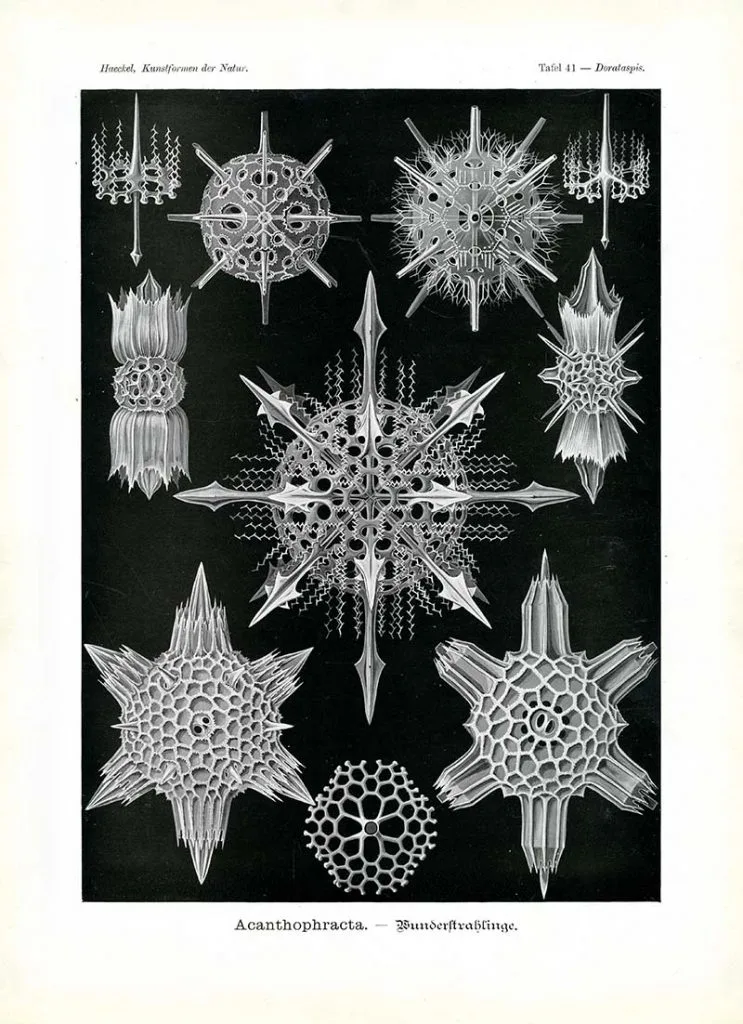
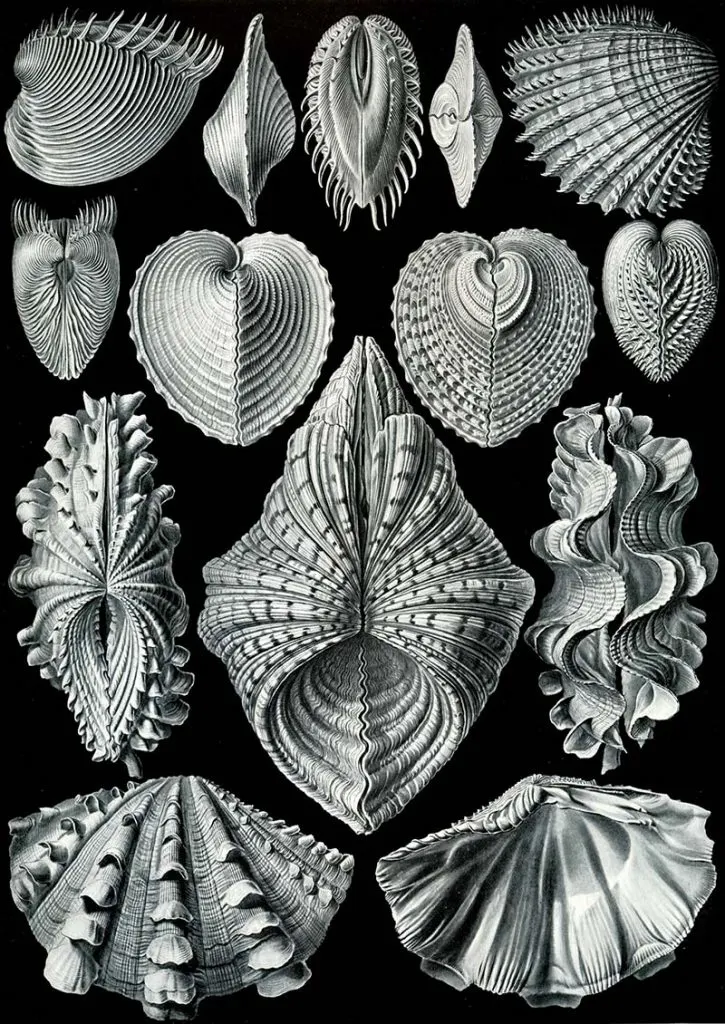
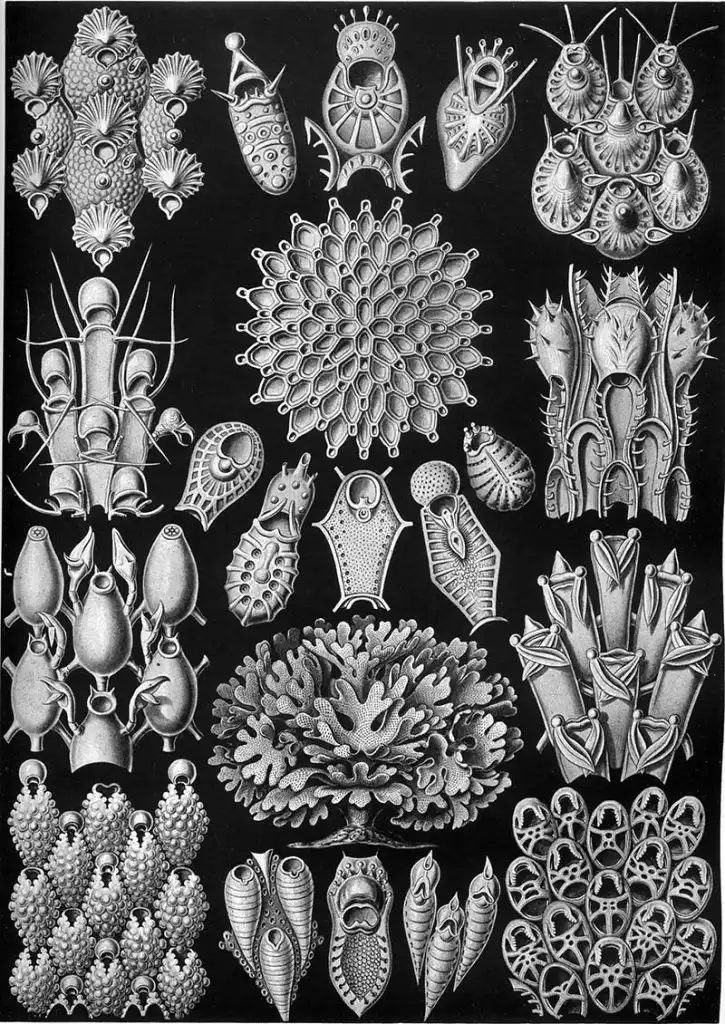
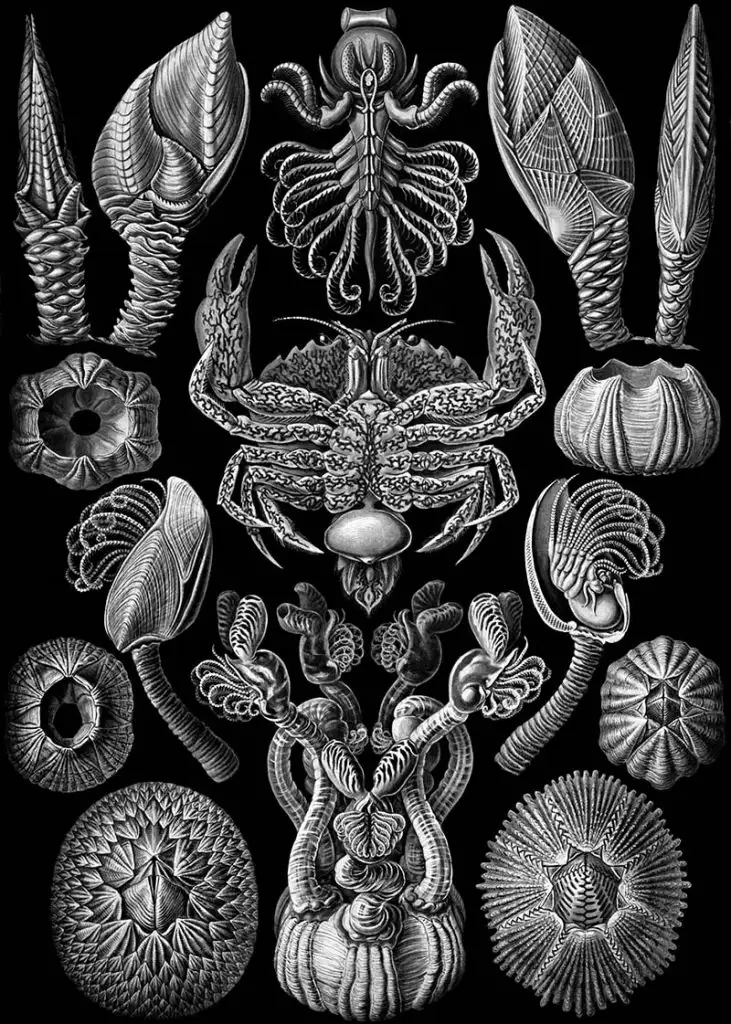
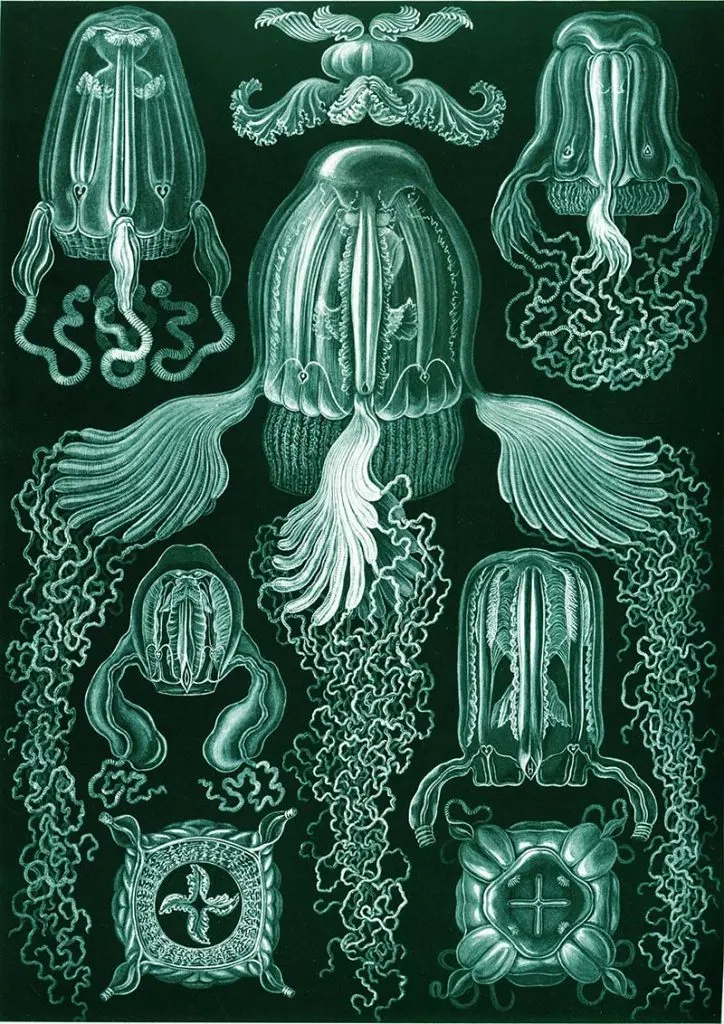
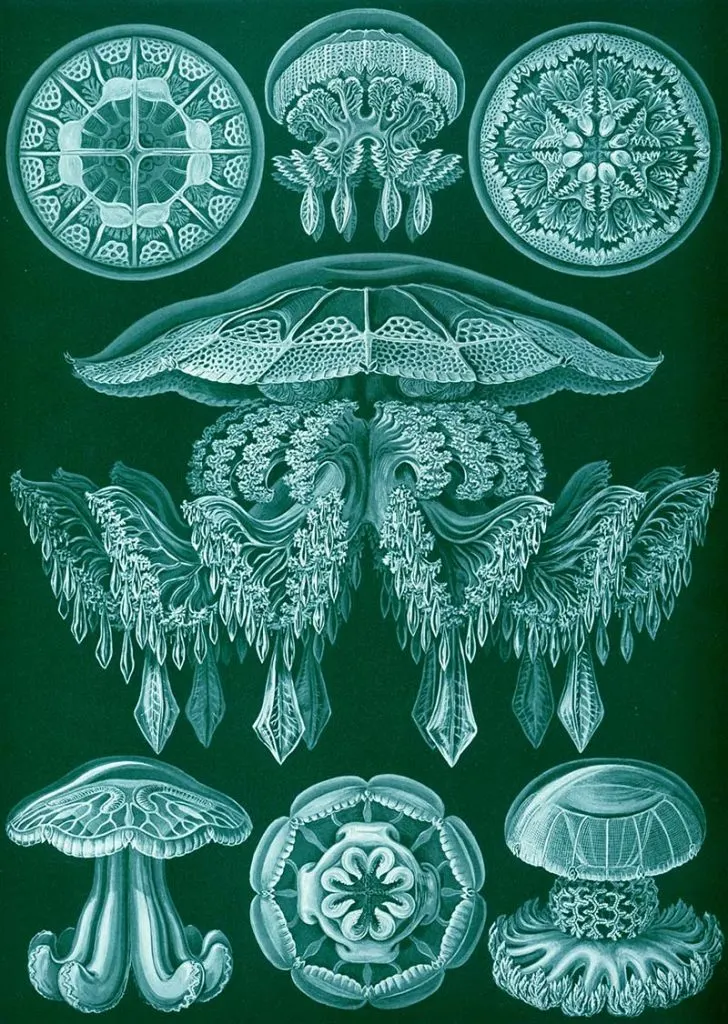
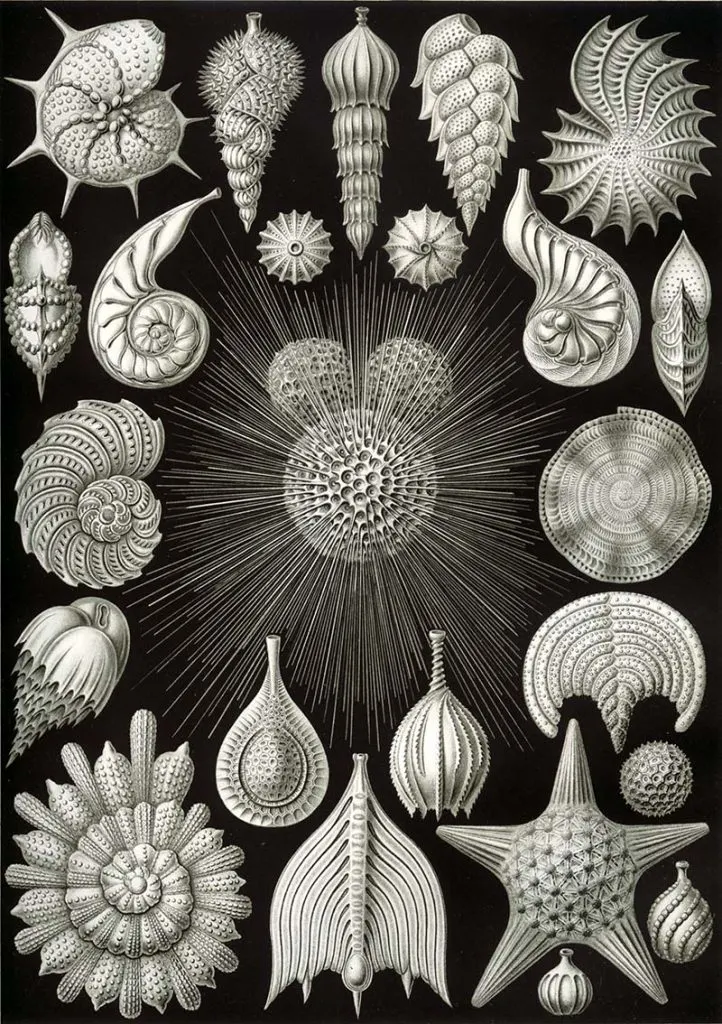
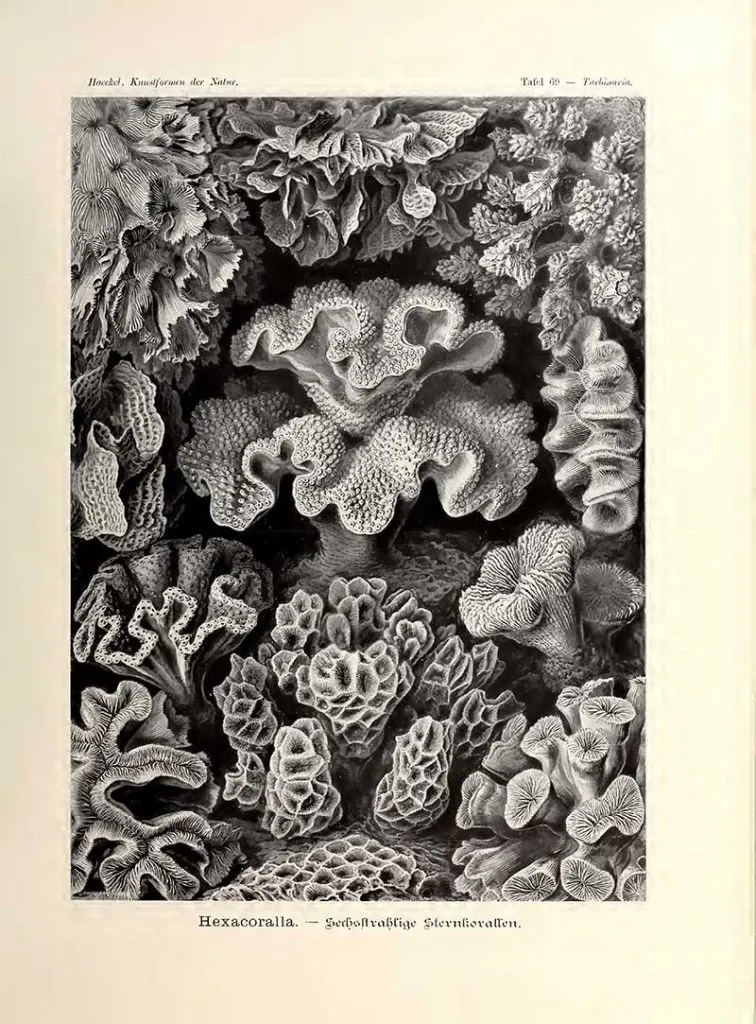
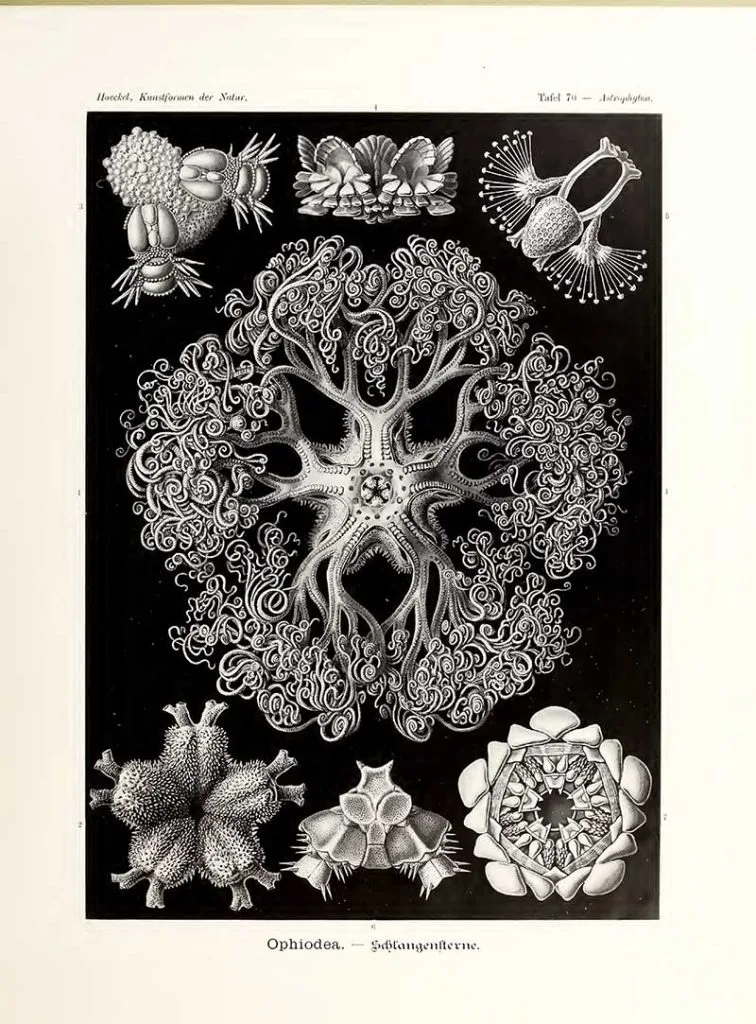
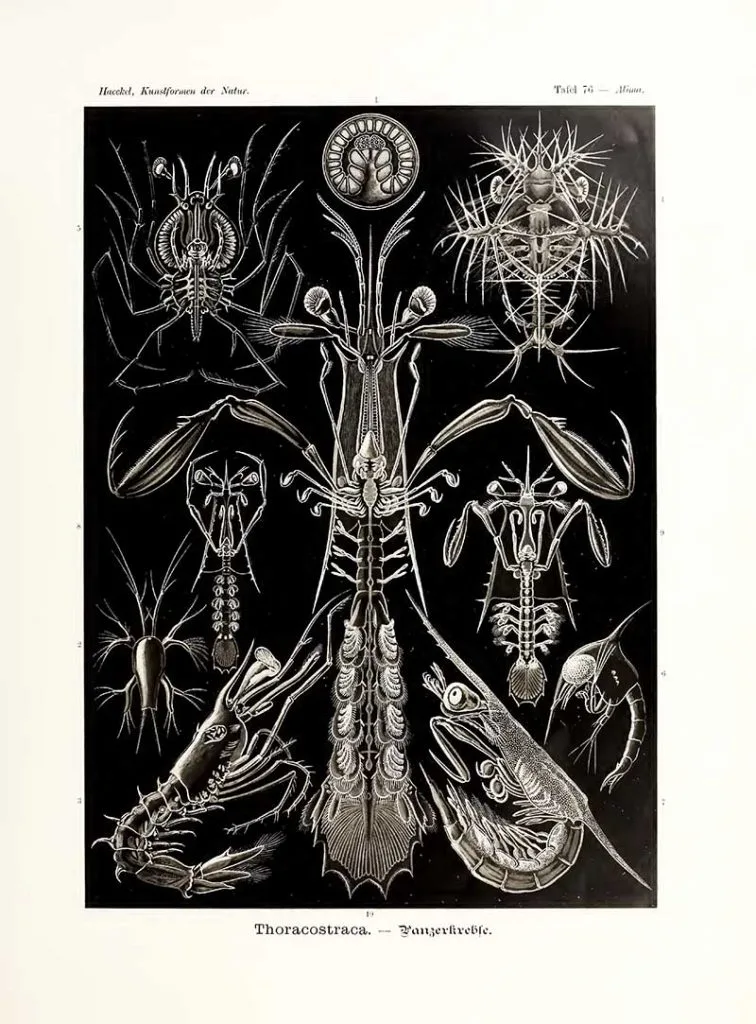
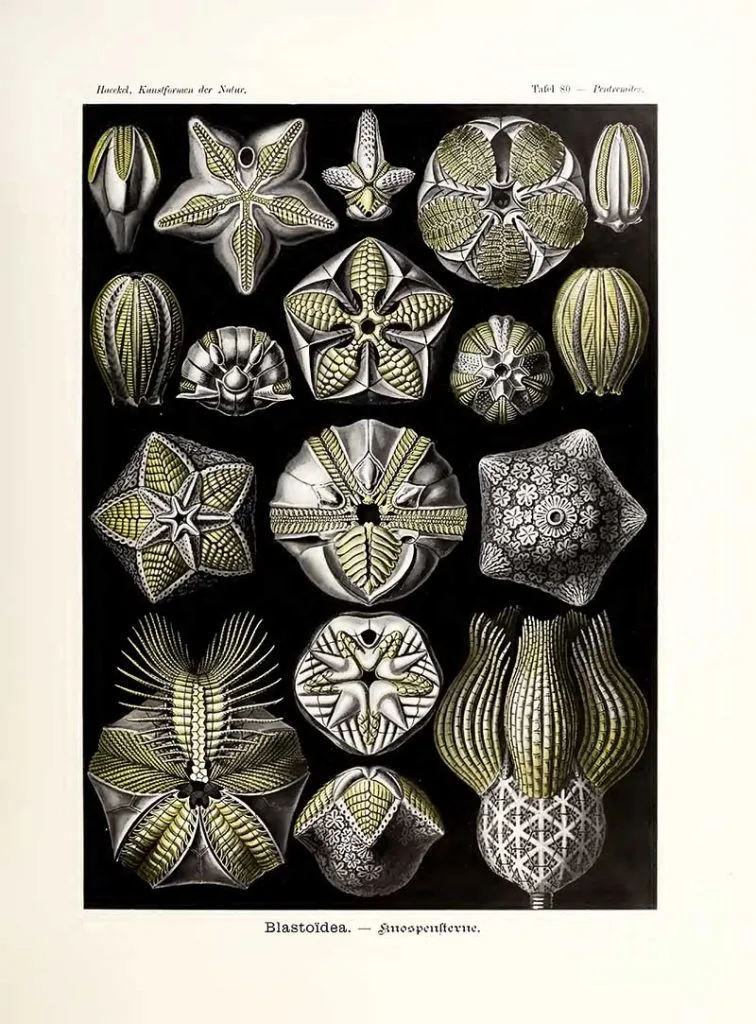
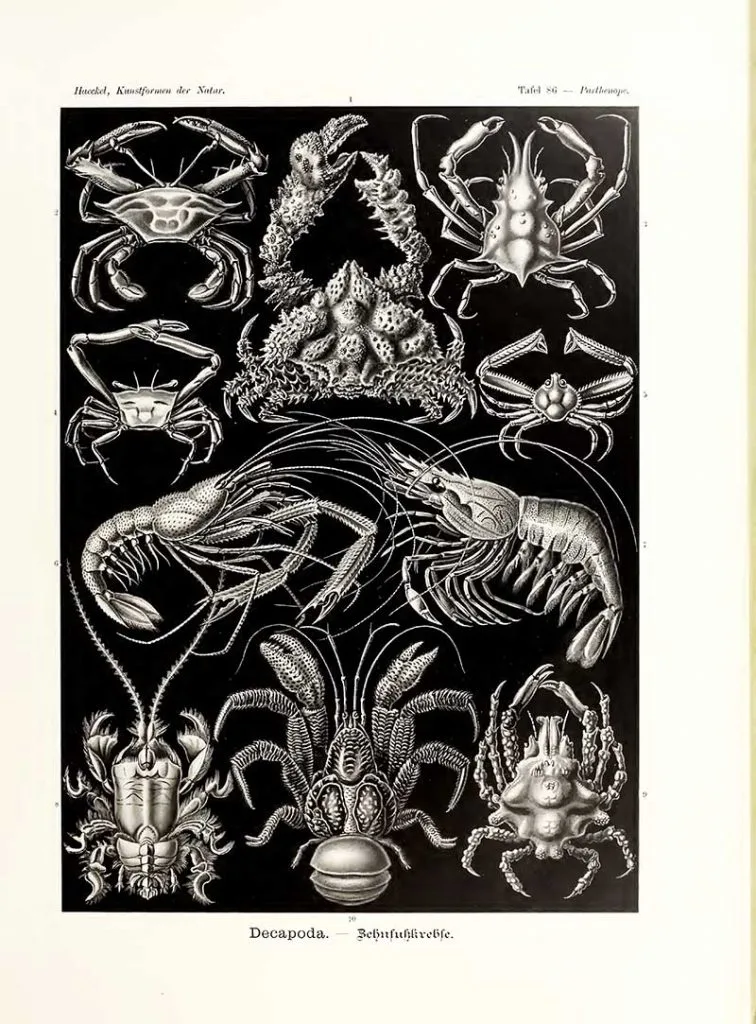

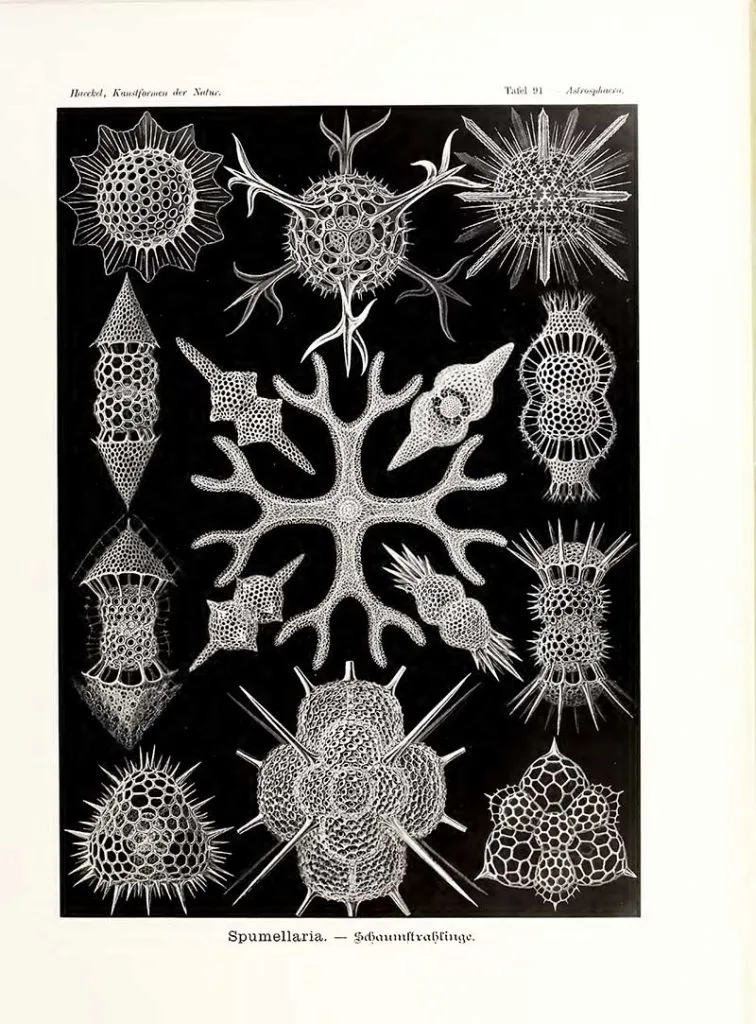
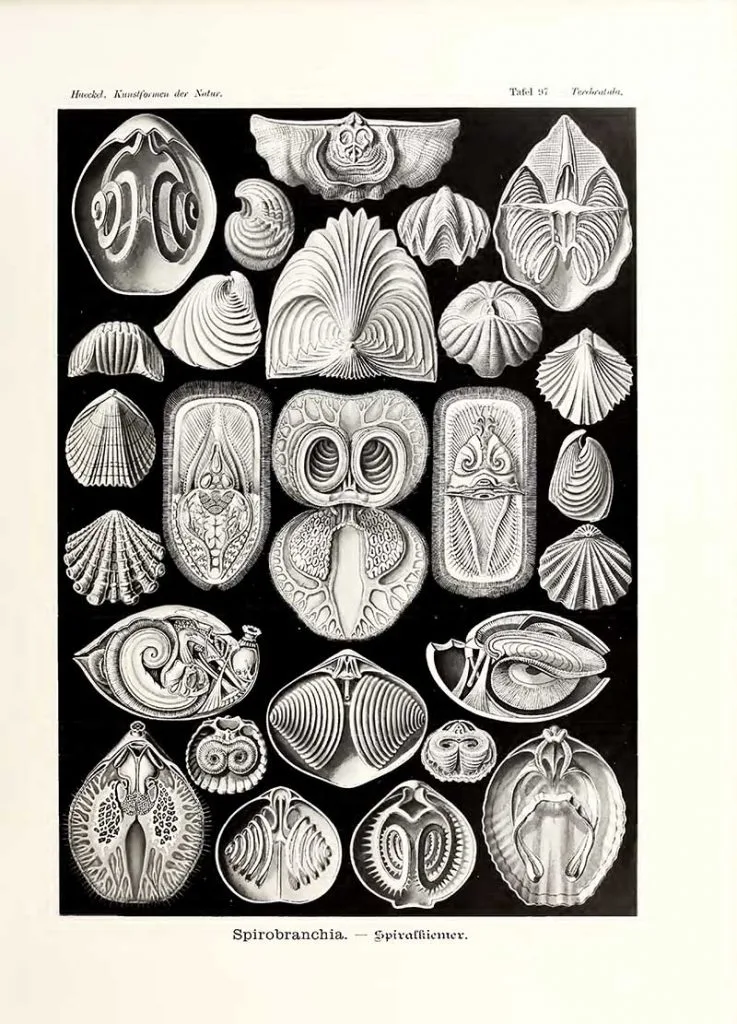

Pedro Henrique
Tuesday 5th of December 2023
Thank you very much for making them available in one page. They're stunning, beautiful. <3
claire
Tuesday 5th of December 2023
You're welcome. I'm glad you enjoyed them.
annadora khan
Friday 10th of February 2023
I love Haeckel and I love what you do for all of us Claire.
claire
Saturday 11th of February 2023
Aww, that’s nice to hear thank you so much. His illustrations are awesome.
Marisa
Saturday 25th of September 2021
Beautifully stunning prints!
claire
Monday 27th of September 2021
Thank you so much.
Rachelle
Saturday 1st of August 2020
Wonderful works of art. I think the black on white are my favorite.
claire
Sunday 2nd of August 2020
Thank you, they are lovely.
Laia
Friday 5th of June 2020
Thank you! It's really refreshing to see how beautiful is nature.
claire
Friday 5th of June 2020
Thank you, it is amazing how beautiful the patterns and colours are in nature.